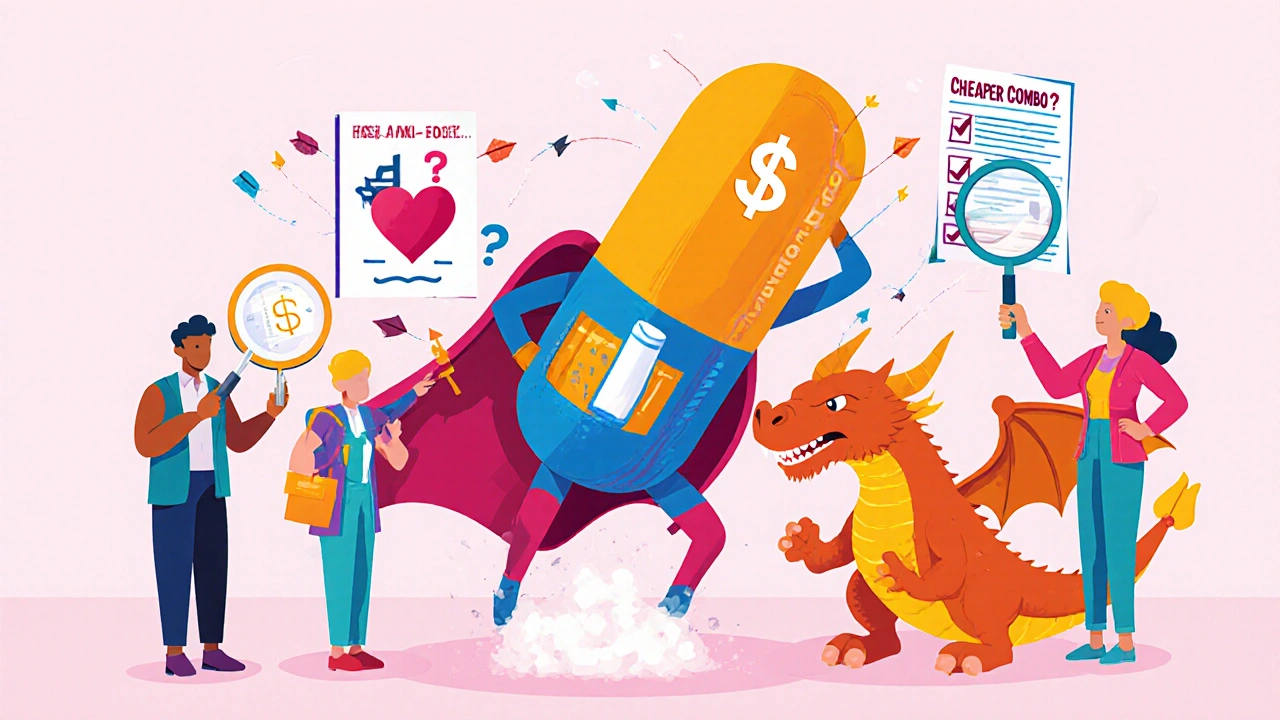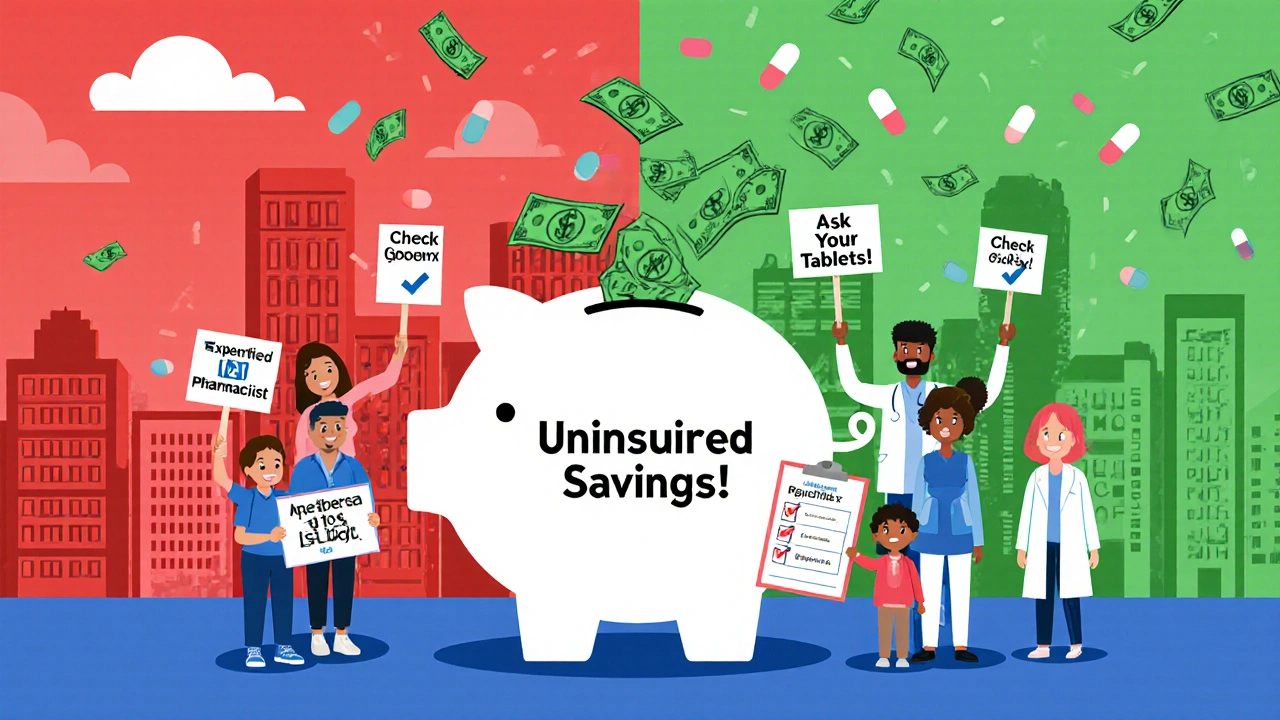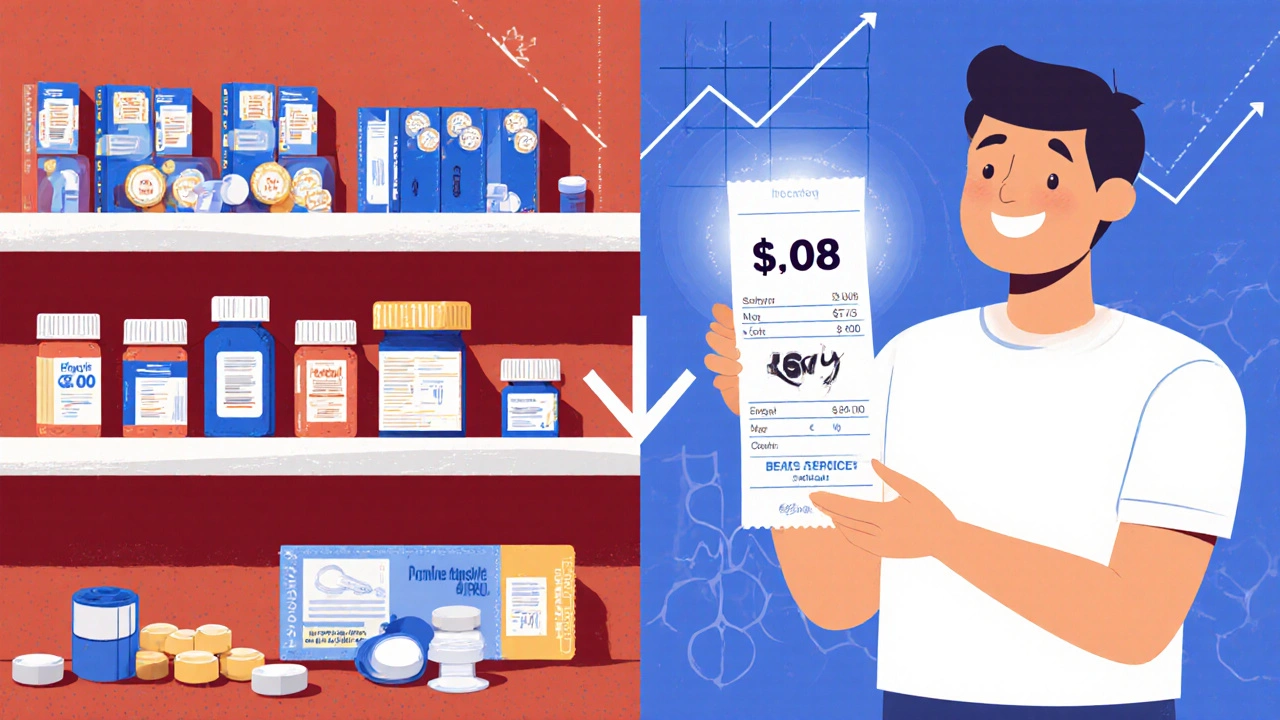When you pick up a prescription, you might assume all generics are created equal. But that’s not true. Some generic drugs cost way more than others-even when they do the exact same thing. And here’s the kicker: sometimes, buying two separate generics costs more than one combination pill that does the same job. The truth is, smart choices in generic medications can save you hundreds, even thousands, of dollars a year. It’s not about brand names anymore. It’s about knowing which generics actually save money-and which ones don’t.
Why Some Generics Cost More Than Others
Not all generics are cheap. In fact, some are shockingly expensive. A 2022 study looked at the top 1,000 generic drugs in Colorado and found 45 that were priced way above their clinical equivalents. These weren’t brand-name drugs. They were generics. And they were charging up to 15.6 times more than other generics that worked just as well. That’s not a mistake. It’s a market flaw. Take Crestor, for example. When the brand version lost patent protection in 2015, the generic version dropped from $5.78 per pill to just $0.08. That’s a 99% drop. But not every generic followed that pattern. Some manufacturers kept prices high, even when others slashed theirs. Why? Because competition isn’t always enough. If only one or two companies make a certain generic, prices stay inflated. But when five or six companies enter the market, prices plunge. The FDA found that with three competitors, prices drop by about 20% within three years. With more, the savings get even bigger.Combination Drugs: One Pill, Two Drugs, Big Savings
Combination drugs-pills that contain two medications in one-are often the secret to big savings. Take asthma inhalers. Before generics hit the market, Advair Diskus cost about $334 per inhaler. That’s a lot for a monthly supply. Then Wixela Inhub, a generic version of Advair, came out. It cost $115. That’s a 65.6% drop. And it’s not just one drug. Advair combines an inhaled corticosteroid and a long-acting beta agonist. Instead of buying two separate inhalers (each with their own generic version), patients got one pill that did both jobs. And it cost less. The same pattern shows up in other areas. For blood pressure, combining lisinopril and hydrochlorothiazide in one pill saves money over buying them separately. For diabetes, metformin and sitagliptin together cost less than two individual pills. Why? Because combination products reduce manufacturing, packaging, and distribution costs. They also cut down on pharmacy fees. One prescription instead of two means fewer copays, fewer trips to the pharmacy, and less confusion for patients.Therapeutic Substitution: Swapping Expensive Generics for Cheaper Ones
You don’t always need to switch to a combination drug. Sometimes, you just need to switch to a different generic. The JAMA Network Open study found that 62% of the high-cost generics they identified could be replaced with a different dosage form or strength of the same drug. For example, a 10 mg tablet might cost $50, but a 20 mg tablet that can be split in half costs just $8. That’s a 94% savings. Pharmacists can often swap these without changing the treatment-so long as the drug is scored and safe to split. The FDA’s Orange Book lists which generics are therapeutically equivalent. If a generic has an “A” rating, it’s interchangeable with the brand name or another generic. But many doctors and patients don’t know this. They assume if it’s generic, it’s cheap. It’s not. And if your pharmacist doesn’t suggest a cheaper alternative, you might be overpaying.
Who Saves the Most? Patients Without Insurance
The biggest savings go to people who pay out of pocket. A 2023 study of the Mark Cuban Cost Plus Drug Company found that uninsured patients saved an average of $6.08 per prescription. That’s more than double the savings for people with private insurance. Why? Because insurance companies often have negotiated rates that make the price difference between generics smaller. Uninsured patients pay the full list price-so when a cheaper generic appears, the gap is huge. Medicare patients saw $4.64 in savings per prescription. Private insurance, $3.69. Medicaid? Almost no savings. That’s because Medicaid already pays low rates, so there’s little room to drop further. But for the uninsured, switching to a cheaper generic or combination drug can mean the difference between taking your meds and skipping them.How to Find These Savings Yourself
You don’t need a degree in pharmacology to save money on generics. Here’s how to do it:- Ask your pharmacist: “Is there a cheaper generic version of this?” or “Can I get this as a combination pill?”
- Check your prescription for dosage. A higher-strength tablet that you can split may cost much less.
- Use tools like GoodRx or SingleCare to compare cash prices at local pharmacies. Sometimes, the price varies by 300% between stores.
- Ask your doctor if your condition can be treated with a combination drug. Many conditions-like high blood pressure, asthma, or HIV-have proven combination options.
- Review your list of meds every six months. New generics come out all the time. What cost $50 last year might now cost $8.

Why This Matters Beyond Your Wallet
Saving money on meds isn’t just about avoiding high bills. It’s about sticking to your treatment plan. When people can’t afford their drugs, they skip doses. They cut pills in half without medical advice. They stop taking them altogether. That leads to hospital visits, emergency care, and worse health outcomes. The U.S. spends over $400 billion a year on prescription drugs. Generics make up 90% of prescriptions but only 23% of that spending. That’s because generics work. But only if we use them right. When insurers and patients choose the lowest-cost therapeutic option-not just any generic-we save billions. The 2022 study estimated that switching just 45 high-cost generics to cheaper alternatives could save $6.6 million in one state alone. Multiply that across the country, and you’re talking about billions.What’s Holding Back More Savings?
There are barriers. Some pharmacies won’t automatically substitute. Some doctors aren’t trained to ask about cost. Some insurance plans still favor certain generics because of rebates from manufacturers-not because they’re cheaper or better. And some companies hold patents on delivery systems or packaging, keeping prices high even after the active ingredient goes generic. The FDA approved 724 generic drugs in 2023, but that’s down from 843 in 2017. Fewer approvals mean less competition. Less competition means higher prices. We need more transparency. We need better incentives for manufacturers to enter crowded markets. And we need patients to speak up.Bottom Line: You Have Power
You don’t have to accept whatever price is on the label. Generics are supposed to save you money. But they only do if you know where to look. Ask questions. Compare prices. Consider combination pills. Split tablets if your doctor says it’s safe. And don’t assume a generic is cheap just because it’s not brand-name. The real savings come from choosing the right generic-not just any generic.Every time you switch to a lower-cost alternative, you’re not just saving money. You’re helping the system work better-for you, for others, and for the future of affordable care.
Are combination drugs always cheaper than taking two separate generics?
Not always, but often. Combination drugs reduce costs by combining manufacturing, packaging, and dispensing into one unit. For example, Wixela Inhub (a generic asthma combo) costs 65% less than the brand Advair. But if two separate generics are already very cheap-like $5 each-buying them individually might still be cheaper than a combo that costs $12. Always compare cash prices at your pharmacy.
Can I split a higher-dose generic pill to save money?
Yes, if the pill is scored and your doctor approves it. For example, a 20 mg tablet that costs $8 can be split into two 10 mg doses, saving you 90% compared to buying 10 mg pills at $5 each. Not all pills can be split safely-especially extended-release or capsule forms. Always check with your pharmacist or doctor before splitting.
Why do some generics cost more than others even though they have the same active ingredient?
It’s about competition and market control. If only one or two companies make a generic, they can keep prices high. When five or more companies enter the market, prices drop sharply. Some manufacturers also use packaging or delivery methods protected by patents, preventing cheaper versions from entering. This is why a generic for a common drug like metformin can cost $4 at one pharmacy and $40 at another.
How do I know if a generic is therapeutically equivalent to the brand?
Look for the FDA’s Orange Book, which lists all approved generics and their therapeutic equivalence ratings. Generics with an “A” rating are considered interchangeable with the brand. Your pharmacist can check this for you. If a generic has an “AB” rating, it’s approved as a direct substitute. Avoid generics with “B” ratings-they’re not considered equivalent.
Do insurance plans encourage switching to cheaper generics?
Some do, some don’t. Many insurance plans have tiered formularies that push patients toward lower-cost generics. But others still favor certain brands or generics because they get rebates from drugmakers-not because they’re cheaper. Always ask your pharmacy benefit manager (PBM) or insurer: “Is there a lower-cost generic alternative for this prescription?”


vinod mali
November 17, 2025 AT 08:51Been using generic metformin for years. Found out my 1000mg pills cost $3 at Walmart but the 500mg ones were $25. Split em. Saved $200 a year. No doctor needed to sign off, just asked the pharmacist. Simple stuff.
Also noticed some generics have weird packaging that makes them pricier. Same drug, same pill, just fancier bottle. Don't fall for it.
Jennie Zhu
November 17, 2025 AT 15:57It is imperative to underscore the significance of therapeutic equivalence as delineated by the FDA’s Orange Book. The designation of an 'A' rating signifies bioequivalence and interchangeability, which is a critical criterion for cost-containment strategies within pharmacoeconomic frameworks. Failure to recognize this distinction may result in suboptimal therapeutic outcomes and unnecessary fiscal burden on both individual patients and systemic healthcare infrastructure.
Kathy Grant
November 19, 2025 AT 01:35I remember when I was diagnosed with hypertension and my doctor prescribed lisinopril and HCTZ separately. I was paying $70 a month. Then my pharmacist asked if I’d ever considered the combo pill. I said no, I thought it was just a marketing gimmick. Turns out it was $12. Same effect. I cried in the parking lot.
It’s not just about money. It’s about dignity. Being able to take your meds without stress? That’s healthcare. That’s love.
Why do we make people choose between food and medicine? We shouldn’t.
I tell everyone I know. Don’t assume. Ask. Always ask.
Jennifer Howard
November 19, 2025 AT 22:02Everyone says 'just ask your pharmacist' like it's that easy. Have you ever tried talking to a pharmacist who's been on their feet for 10 hours? They don't care. They just want you to leave. And the insurance companies? They push the most expensive generics because they get kickbacks. It's all rigged. You think you're saving money? You're being played.
And don't even get me started on pill splitting. What if you split it wrong? What if the coating is time-release? You're just poisoning yourself.
People need to stop being so naive.
Abdul Mubeen
November 20, 2025 AT 14:07Let’s be honest: this whole 'generic savings' narrative is a distraction. Big Pharma doesn’t care about you. They just want you to think you’re getting a deal so you don’t question why insulin costs $300. The real issue is patent evergreening, monopolistic control of delivery systems, and the FDA’s slow approval process. This article is a feel-good lie. You’re not saving money-you’re being manipulated into accepting crumbs.
mike tallent
November 22, 2025 AT 00:09YES YES YES 😊
Just switched my asthma meds to Wixela. Saved $220/month. My dog even noticed I was less stressed 😅
Pro tip: Use GoodRx + CVS coupon = $11 for the inhaler. I thought I was dreaming.
Also, if your doctor doesn’t know about combo pills, bring them this article. They’ll thank you later.
Spread the word. This is real life-saving stuff 💪
Joyce Genon
November 22, 2025 AT 01:34Let’s not romanticize this. Yes, some generics are cheaper. But the entire system is a mess. You think people are just 'not asking'? No. Most people are terrified of their doctors, confused by insurance, and overwhelmed by the sheer volume of pills they’re supposed to take. And now you want them to become pharmacologists on top of everything else? This isn't empowerment-it's victim-blaming.
Also, the study you cited? It was in Colorado. Try living in rural Mississippi. There’s no pharmacy within 50 miles. No GoodRx. No pharmacist who gives a damn. Your 'solution' doesn’t scale. It’s a luxury for the urban middle class. The rest of us are just trying not to die.
John Wayne
November 23, 2025 AT 08:59How quaint. You believe that competition drives prices down? That’s textbook economics. But in reality, the FDA’s approval process is a bottleneck engineered to protect oligopolies. The 724 generics approved in 2023? Most were minor variations. True innovation? Stifled. The real savings come from dismantling the regulatory capture that keeps prices high. Not from splitting pills like some DIY hobbyist.
Julie Roe
November 23, 2025 AT 19:23I work at a community clinic. I’ve seen people skip doses because they can’t afford their meds. One woman was taking half her blood pressure pill every other day. She said she didn’t want to be a burden. That broke me.
But then I showed her how to switch to the combo pill. She cried. Not because she was sad-because she realized she didn’t have to suffer like this.
It’s not just about money. It’s about dignity. And it’s not just patients. Pharmacists want to help. Doctors want to help. The system just doesn’t let them.
So yes-ask. Compare. Split if it’s safe. But also-push your reps. Write letters. Make noise. This isn’t a personal fix. It’s a systemic one. And we’re all in it together.
jalyssa chea
November 25, 2025 AT 18:37lol u think splitting pills is safe? My cousin did that and ended up in ER because the pill was extended release and it all dumped at once. Now he’s on dialysis. So thanks for your 'tips'.
Also why do u always say 'ask your pharmacist'? Like they have time? They’re overworked and underpaid. And if u think the FDA orange book is easy to read u are delusional. It’s written in legalese.
And don’t even get me started on goodrx. They sell ur data. U think they care about u? Nah. They just want u to buy more junk.
Gary Lam
November 27, 2025 AT 14:04Man, I’m from India and we’ve been doing this for decades. One pill for BP + diabetes? Standard. Why pay for two boxes, two labels, two trips? We call it ‘combo pack’ and it’s everywhere.
But here? You need a PhD just to buy aspirin.
Y’all need to chill and stop treating medicine like it’s a luxury car. It’s a lifeline. Not a status symbol.
Peter Stephen .O
November 29, 2025 AT 01:03Bro this is wild. I didn’t know you could split pills. I’ve been paying $45 for my 10mg lisinopril for two years. Just found out the 20mg is $9. Split it. Now I’m saving $400 a year.
And I didn’t even know the FDA had a freaking Orange Book. I thought that was a fruit brand.
Also-Wixela? I thought it was a new anime. Turns out it’s a lifesaver.
Why is this not on TV? Why aren’t we screaming about this? This is the most important thing I’ve learned since I found out you can microwave a potato in a paper towel.
Pass this to your grandma. Pass it to your cousin. Pass it to your ex. Everyone needs to know.
Andrew Cairney
November 29, 2025 AT 02:09Everything you’re saying is true… but who’s really behind this? 🤔
Big Pharma + PBMs + Pharmacy chains = a three-headed monster. They want you to think you’re saving money by switching generics… but they’re just moving you from one overpriced option to another. The combo pills? They’re often owned by the same company that made the brand. The 'cheap' generic? Maybe it’s made in a factory that pays $2/hour. The real problem? Lack of transparency. No one wants you to know who owns what.
And GoodRx? They’re not your friend. They’re a data broker. You think you’re saving? You’re being tracked.
Wake up. This isn’t empowerment. It’s manipulation with better packaging.
Rob Goldstein
November 30, 2025 AT 06:37From a clinical pharmacology standpoint, the therapeutic substitution paradigm is one of the most underutilized cost-containment levers in outpatient care. The pharmacoeconomic data is robust: when clinicians and patients opt for therapeutically equivalent generics with higher dosage strengths that are scored and safe for splitting, the per-unit cost decreases by an average of 78-92%.
Moreover, fixed-dose combination therapies reduce pill burden, which directly correlates with improved adherence rates-critical for chronic conditions like HTN, T2DM, and asthma.
Pharmacists are key stakeholders in this process and should be empowered to initiate therapeutic substitutions under protocol. We need standardized EHR alerts and formulary optimization to make this scalable. This isn’t just a patient issue-it’s a systems issue.